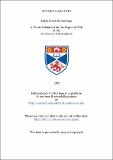Apuleius and Lyly
Abstract
This work is a study of the contribution which Apuleius' Metamorphoses made to the development of the Euphuistic style apparent in John Lyly's Euphuest The Anatomy of Wit. While not proving conclusively Apuleius' direct influence on Lyly's work" it does provide a sound argument that Meta- morphoses exhibits the same Euphuistic elements present in Euphues. To illustrate the similarities between these two works, a study of the authors' lives, of thematic similarities in the works, of the origin of Euphuism, and of the grammatical devices in both works has been included. The authors' lives are examined primarily in respect to their education and works, along with an analysis of probable influences on their writing styles. Furthermore, the influence of Adlington's translation of Metamorphoses and of Lyly's Euphues on the Renaissance Period in England is considered. Within this study, the two works are presented as possible autobiographies. Besides an analysis of the authors' lives, a discussion of theme and plot similarities reveals that each work deals with a protagonist's difficulties due to his reckless curiosity. Ultimately, both heroes are punished for their curiosity (Lucius in his transformation into an ass and Euphues in his loss of Lucilia), and both heroes receive some mercy (Luicus through his dedication to Isis and Euphues through his vow to forsake women and to pursue education). An analysis of Euphuism's origin begins by defining the Euphuistic style Lyly employs and by studying the Asianic influence on that style. Moreover, an examination of past theories concerning the origin of Euphuism is included as they represent conflicting opinions on that source. At this point, a discussion of Apuleius' debt to the classics illustrates that both Apuleius and Lyly draw upon the same sources in creating a Euphuistic style, though both of these authors exhibit similar stylistic traits which set them apart from these sources. Having surveyed various theories on the origin of Euphuism, an analysis of the development of style in Apuleius' Metamor-phoses and Lyly' s Euphues t The Anatomy of Wit is organized into two separate chapters; one deals with the usage of individual letters (including annomination, transverse alliteration, assonance, consonance, and rhyme), while the other concerns the usage of the word as a unit (antithesis of ideas and sounds, isocola, pleonasm, personification, puns, repetition, rhetorical questions, and classical allusions), Finally, conclusions regarding the authors' similarities in style are drawn. Here, the stylistic differences due to the two separate languages employed and common factors present in both works are examined in detail, a complete frequency chart of grammatical devices in both works is included to document clearly the evidence presented.
Type
Thesis, PhD Doctor of Philosophy
Collections
Items in the St Andrews Research Repository are protected by copyright, with all rights reserved, unless otherwise indicated.

